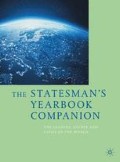You have full access to this open access chapter, Download reference work entry PDF
Factsheet
-
Capital: Melekeok
-
Population estimate, 2015: 21,000
-
GNI per capita, 2014: (PPP$) 13,496
-
HDI/world rank, 2014: 0.780/60=
-
Internet domain extension: .pw
Civil Aviation
The main airport is on Koror (Roman Tmetuchl International Airport, near Airai). In 2010 there were scheduled flights to Guam, Manila, Seoul, Taipei and Yap (Micronesia). A new Palau-based carrier, Palau Airways, was founded in 2011 and launched scheduled passenger services between Koror and Taipei in May 2012, but it halted its operations in April 2013.
Climate
Palau has a pleasantly warm climate throughout the year with temperatures averaging 81 °F (27 °C). The heaviest rainfall is between July and Oct.
Constitution and Government
The Constitution was adopted on 2 April 1979 and took effect from 1 Jan. 1981. The Republic has a bicameral legislature, the Olbiil Era Kelulau (National Congress), comprising a 13-member Senate and a 16-member House of Delegates (one from each of the Republic’s 16 states), both elected for a term of 4 years as are the President and Vice-President. Customary social roles and land and sea rights are allocated by a matriarchal 16-clan system.
Currency
US currency is used.
Labour
In 2005 the total labour force numbered 10,203 (6,214 males and 3,989 females), of whom 9,777 were employed (5,982 males and 3,795 females).
Press
There are three local newspapers—Island Times, Tia Belau and Palau Horizon—although none are published daily.
Religion
The majority of the population is Roman Catholic.
Roads
There were 146 km of roads in 2007 including the 85-km US-funded two-lane highway around Babelthuap, providing a link between the old capital of Koror and the new capital of Melekeok.
Shipping
There is a port at Malakal.
Social Statistics
2012 births, 268; deaths, 164. Rates, 2012 (per 1,000 population): births, 12.7; deaths, 7.8; infant mortality (2012), 12 per 1,000 live births. Annual population growth rate, 1998–2008, 1.0%. Expectation of life at birth, 2010: males, 61 years; females, 68. Fertility rate, 2008, 1.9 births per woman.
Telecommunications
In 2008 there were 7,400 main (fixed) telephone lines and 12,200 mobile phone subscribers.
Territory and Population
The archipelago lies in the western Pacific and has a total land area of 488 km2 (188 sq. miles). It comprises 26 islands and over 300 islets. Only nine of the islands are inhabited, the largest being Babelthuap (396 km2), but most inhabitants live on the small island of Koror (18 km2) to the south. In Oct. 2006 the capital moved from Koror to Melekeok, a newly-built town in eastern Babelthuap. The total population of Palau at the time of the 2012 census was 17,501 (9,217 males and 8,284 females), giving a density of 35.9 per km2. In 2005 approximately 73% of the population were Palauans and 16% Filipinos. In 2011, 84.3% of the population lived in urban areas. Some 6,000 Palauans live abroad. The local language is Palauan; both Palauan and English are official languages.
Tourism
Tourism is a major industry, particularly marine-based. There were 83,795 visitor arrivals in 2009 (down from a record 94,895 in 2004). Of the visitor arrivals in 2009, 68,329 were for tourist purposes. Visitors to Palau in 2009 included: 27,180 from Japan; 16,571 from the Republic of China; 13,193 from the Republic of Korea.
Copyright information
© 2019 Springer Nature Limited
About this entry
Cite this entry
(2019). Palau. In: The Statesman’s Yearbook Companion. Palgrave Macmillan, London. https://doi.org/10.1057/978-1-349-95839-9_1448
Download citation
DOI: https://doi.org/10.1057/978-1-349-95839-9_1448
Published:
Publisher Name: Palgrave Macmillan, London
Print ISBN: 978-1-349-95838-2
Online ISBN: 978-1-349-95839-9
eBook Packages: Political Science and International StudiesReference Module Humanities and Social SciencesReference Module Business, Economics and Social Sciences

